by Gabi Cox | Apr 17, 2024 | News
Readyhedge is an innovative and easy way to plan and plant a hedge.
Below we’ll take you through just a few of the benefits of using Readyhedge and how to use our hedging to benefit your garden or outdoor space in just four quick and easy steps.
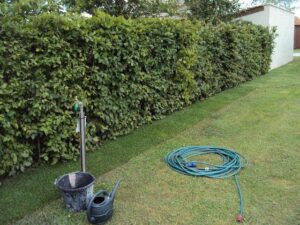
The traditional way of using bare root or field-grown hedging involves measuring and then working out how many plants are needed. If a mixed hedge has also been specified, there’s also the job of choosing which species are to be planted. Traditionally hedges are usually comprised of five plants per metre and when planted are a single stem which then needs some sort of protection from rabbits and other grazing animals. This is normally in the form of plastic guards and canes.
A Readyhedge trough is 5 plants in a metre, but they have been growing together for 12 to 18 months and have been trimmed to encourage side shoots. This means that when they are planted, they are already quite dense and do not need this protection from grazing animals.
Bare root hedging has a short window of time in which it can be planted, normally from November to the end of March.
A Readyhedge trough can be planted at any time of the year, meaning that hedging can now be planted all year round. Bare root hedging can also suffer from a 20-25% failure rate in the first year due to replant shock, whereas with a Readyhedge trough this has already been done and so as long as the hedging is cared for correctly it will give you 100% survival.
When planting bare root plants care must be taken to make sure that they do not dry out and that they are planted at the correct depth and without damaging the roots, this can be quite a time-consuming process. A Readyhedge trough just needs a trench that is 19cm deep and 30cm wide and then the hedging can be lifted out of the plastic trough and placed straight in, this means that planting of our instant hedging can take half the time.
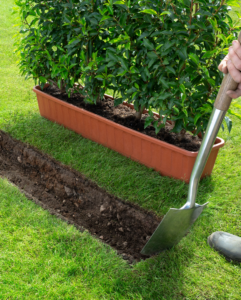
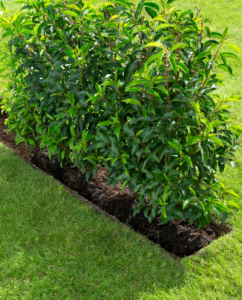
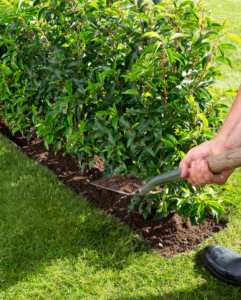
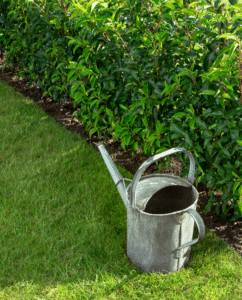
When planting taller plants if you use our Readybag range of hedging, the same applies, it is quicker and easier to plant a Readybag than it is to plant individual plants.
How to use Readyhedge in four quick and easy steps.
- Choose the variety of hedge that you wish to plant
- Measure the length of the area you are putting the hedge into
- Order that number of Readyhedge instant hedging units
- Sit back and await delivery which can be as quick as 48 hours
Keen to get started? Get in touch with our team to discuss what you need!
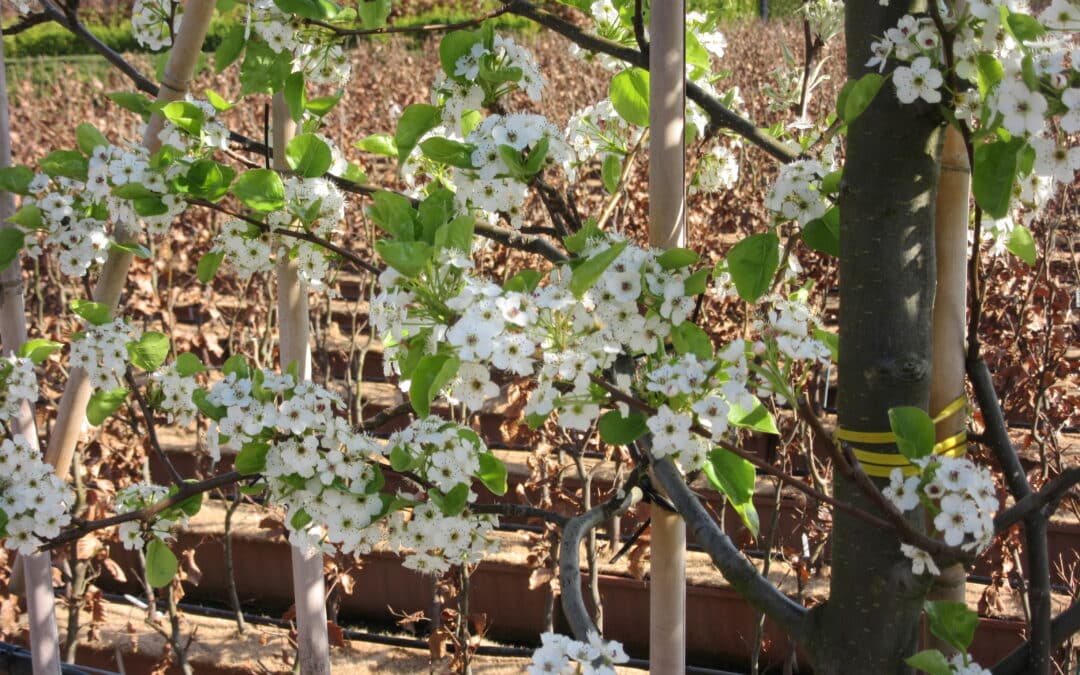
by Gabi Cox | Mar 18, 2024 | News
Readyhedge is known for being a grower of high quality instant hedging but did you know that we also grow nearly 1000 pleached trees each year. Starting with a feathered tree our team of skilled staff train the trees onto a bamboo frame and then grow them on for at least one growing season before they are offered for sale.
The team grow over 10 different species in both evergreen and deciduous and with clear stem heights from 0-180cm.
So how do pleached trees work?
Pleached trees are an amazing addition to a garden and allow for screening to over 3 metres, especially when planted next to a fence or a wall. Having the clear stem allows for the beauty of a natural wall to be seen or the opportunity for decorative planting underneath. While pleached trees are most often used along a boundary to give extra privacy, they can also be used to great effect as free standing features and can be seen in some well known formal gardens in Britain, commonly forming avenues or framing linear water features.
It is hard to pick a favourite out of the trees that we grow at Readyhedge, but we feel the three below are the best deciduous and evergreen screening panels that we grow.
Readyhedge Top Three Deciduous Pleached Trees
Carpinus betulus (Hornbeam)
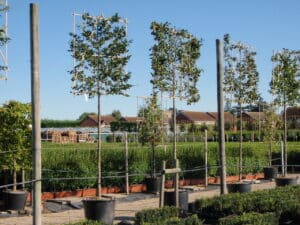
The Hornbeam is one of the most versatile hedging plants that you can find and as a pleached tree it is just as good. Happy growing in all soil types, this variety will perform reliably every year. With lovely fresh green leaves in the spring and retaining a proportion of its old leaves during the winter, it is a great all rounder. With at least a 150cm clear stem, when grown as an aerial screen you get to see the amazing buttresses of the stem, which are normally hidden when grown as hedging. Due to its ease of growth this is the perfect variety to choose for areas where aftercare may be limited.
Pyrus cal. Chanticleer (Ornamental Pear)
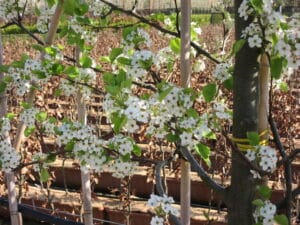
This is a very underrated tree. While it is deciduous, it is one of the last trees to lose its leaves on the nursery, regularly still having leaves in December before coming back into the leaf very early as well. It also has copious quantities of white flowers in the spring which are already fully out this year (early March), which are then followed by the leaves.
While it is a member of the Pear family it does not often set fruit and when it does they are very small and insignificant. The flowers in the spring are amazing but in the Autumn, it’s fiery colour is breathtaking and on a good year could nearly rival the Japanese maples for its colour.
Liquidamber Worplesdon (Sweet Gum)
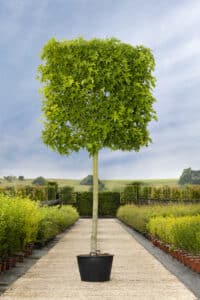
Often confused with the Japanese Maples due to its five lobed leaves, it has a similar autumn colour. The leaves are large and lobed and come out a fresh green in the late spring and if crushed they give out a sweet menthol/eucalyptus scent. Having large leaves means that this type always seems to give you good coverage and privacy from a young age, which can make it a very good choice if you don’t want to wait for an established tree. To add to its beauty, the older branches and trunk can have a corky winged appearance.
Readyhedge Top Three Evergreen Pleached Trees
Prunus lau. Novita
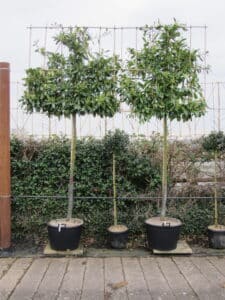
A form of Cherry or Common Laurel, this large leaf evergreen is a great all purpose screening tree. Suitable for nearly all areas and soil types it will happily grow a good dense head. Regular pruning is required to keep it looking at its best as well as removing the white candle like flowers as they fade if you do not want it to produce fruit.
Prunus lus. Angustifolia (Portugal Laurel)
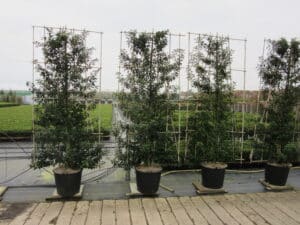
As a standard hedge the Portugal is a firm favourite due to its ability to be trimmed up into formal shapes and dense look. As a pleached tree it is no different and just as stunning. If a high class finish is required this is the go to tree.
Quercus ilex (Holm Oak)
An evergreen British native oak tree with a different grey green leaf, the Holm Oak is very slow to get going and to form a screen but when it does it is amazing. We grow a limited number of these and normally only get up to about a 120cm clear stem. They require some patience and imagination on behalf of a client but for those with the foresight they will be rewarded with a dense pleached tree that is capable of being trimmed up into a very formal finish if that is what is required
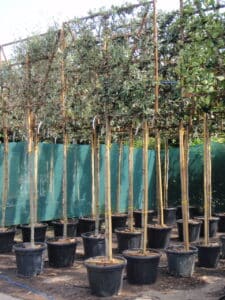
Whichever final look you want to achieve and garden space you’re working with, Readyhedge has a whole host of pleached tree options for you. It’s always worth getting in touch and speaking to the team, as we often have various options of some varieties that will not necessarily appear on the website and possibly not even the stock list.
Get in touch with the team here, we can’t wait to hear from you!
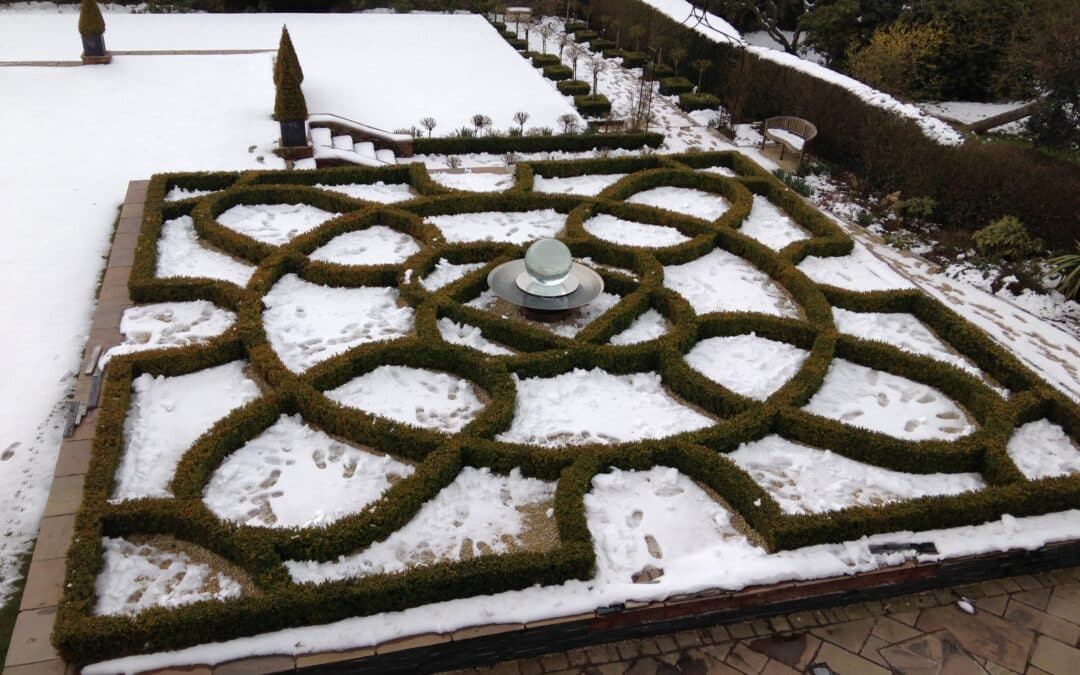
by Gabi Cox | Feb 23, 2024 | News
At Readyhedge, we provide hedging of all shapes and sizes, catering to every type of outdoor space. We know that sometimes all that is needed is a small divider in a garden and this is where the low hedges come in.
Low hedging tends to be evergreen, meaning they can add structure to the garden even in the depths of winter. Best known as knot gardens or Parterres in the grand country houses of the rich and famous, where they are planted in between colourful bedding plants, they are just as useful in a small garden to edge a path or patio to give the garden structure.

In our previous blog post, we discussed all things low hedging including how to incorporate them into your garden, maintenance tips and how to ensure sustainability. Below we look at our top 5 low hedge picks for your garden.
Low Hedge 1: Buxus sempervirens (Common Box)
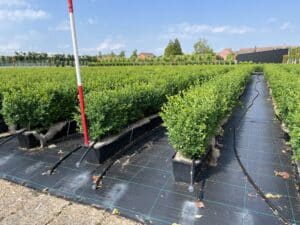
This is the classic low hedge that has been grown for hundreds of years. It is a very slow growing hedge and with two trims a year it can be kept looking amazing. With small evergreen leaves it forms a dense hedge that can be kept at 40cm in height with great ease. It grows 2 – 5 cm a year and over time can grow up to over 180cm in height, although this would take a while.
Currently suffering from bad press because of a box moth caterpillar and the potential effects of blight. The Buxus sempervirens are still a brilliant hedge and with care and treatment both of these problems can be, and are, kept at bay allowing this plant to thrive as an amazing low hedge option.
Low Hedge 2: Taxus baccata (English Yew)
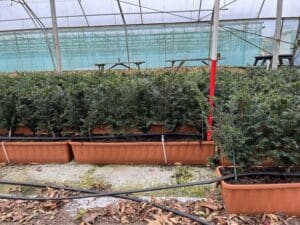
A surprising one as normally seen as a large hedge in a formal garden or even a maze. With regular trimming the English Yew can be kept down to around 40 – 50cm in height. With its dark green foliage it makes a great edge to an outdoor space and also makes for a stunning backdrop for other plants. Good for a Knot garden, it is worth considering as a low hedge as it is easy to get topiary shapes like balls, cones and Pyramids to match up with it. If it does get too big it is possible to cut Taxus down and it will regenerate to form a nice low hedge again.
Low Hedge 3: Euonymus Jean Hugues
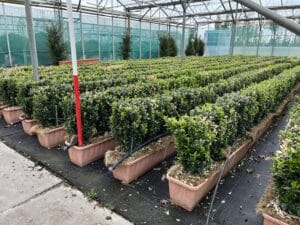
A relatively new hedge form, this plant is making a big inroad into the low, formal hedge market. Evergreen with small green leaves, they are thinner and not as rounded as Box leaves are but still look just as great. At Readyhedge we have been growing this hedge for 5 to 6 years and it can grow up to 80cm tall quite quickly although it is also easy to keep it cut down to around 40-50cm. We would not advise planting this in a really exposed site but we are finding that in more sheltered spots it is a brilliant performing low hedge.
Low Hedge 4: Ilex crenata (Japanese Holly)
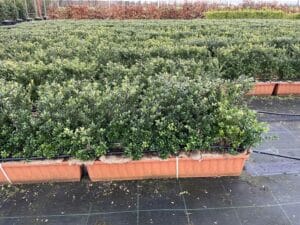
Looking nothing like the holly that you normally see, with small oval leaves and no spines, this is an interesting and slightly different hedge type. As it gets older it gets denser meaning at a young age it can look a bit open but as it matures it fills out and eventually forms a really dense screen.
We grow two types, the first is an Ilex crenata Dark Green which is normally around 30-40cm tall with a lovely dark green leaf. The other is Ilex crenata Caroline Upright which grows taller and has a paler more yellow leaf and this makes a superb hedge in the 70-90cm height range. Both of these plants perform best in a loam soil that is also slightly acidic. They are quite a rigid plant and as such it would be best to use them in areas where they are not likely to be knocked into as they can damage very easily.
Low Hedge 5: Pittosporum Golf Ball
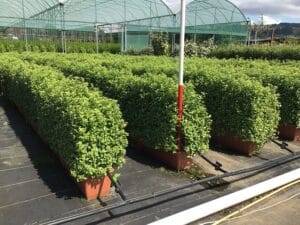
This, as the name suggests, will, if left alone, form a sphere or dome. However, trimmed it makes a lovely low hedge with a pale almost grey green leaf. The Pittosporum Golf Ball tend to be soft looking and not quite as formal as the previous hedges. We would again suggest that these are grown in the milder parts of the country or in sheltered spots as they can show some leaf scorch during the winter.
No matter what look you’re after or the size of your garden, when the right hedge is chosen and planted well, the final outcome can be incredibly effective.



















